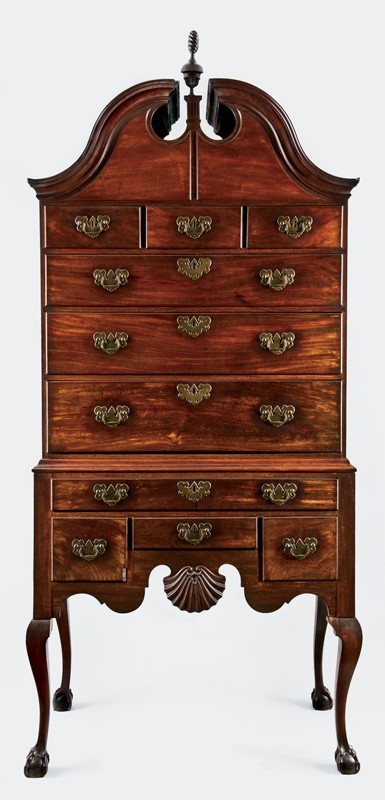
John Townsend, high chest of drawers, Newport, Rhode Island, 1756. Mahogany with white pine and ash. H. 88 1/2", W. 40 1/4", D. 21 1/8". (Private collection; photo, Gavin Ashworth.) This high chest descended in the Arnold family of Warwick, Rhode Island. It retains its original finial, cast brass hardware, and finish.

High chest of drawers attributed to John Townsend, Newport, Rhode Island, ca. 1770. Mahogany with yellow poplar. H. 84 1/2", W. 41", D. 21". (Private collection.) This high chest descended in the Dyer family of Providence, Rhode Island.
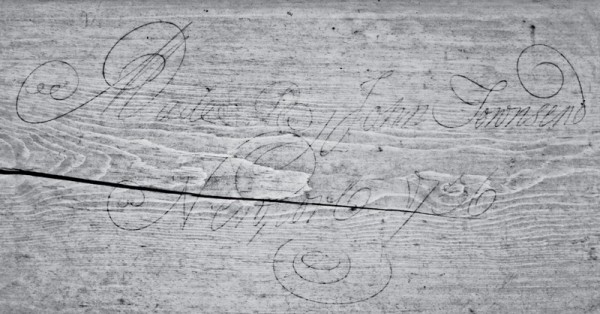
Detail of the graphite signature on the high chest illustrated in fig. 1. (Courtesy, Sotheby’s.)
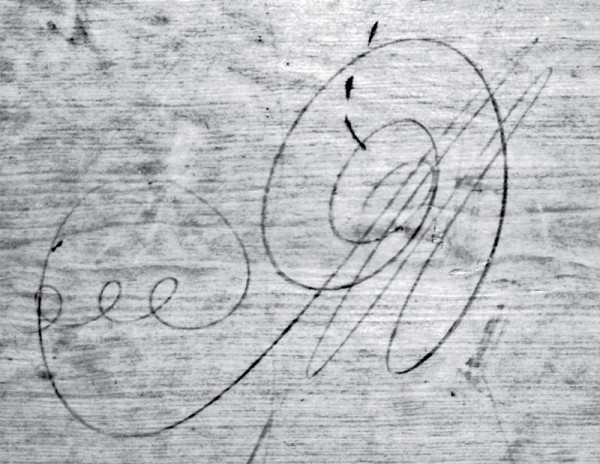
Detail of an “M” finishing mark on the backboard of the high chest illustrated in fig. 1. (Courtesy, Sotheby’s.)

Detail of the lettering on the backs of the upper-case drawers of the high chest illustrated in fig. 1 (Courtesy, Sotheby’s.)

Detail of the lettering on the backs of the lower-case drawers of the high chest illustrated in fig. 1. (Courtesy, Sotheby’s.)
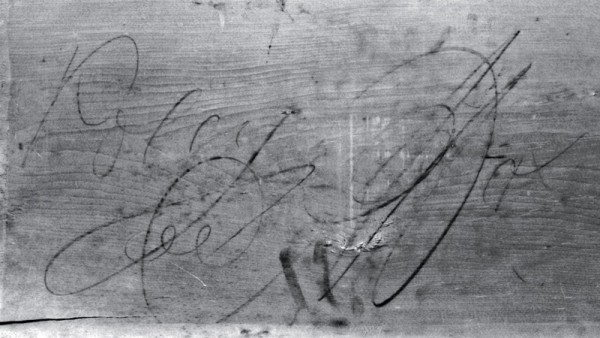
Detail of the inscription “Polly” on the bottom of a drawer in the upper case of the high chest illustrated in fig. 1. (Courtesy, Sotheby’s.)

Detail of the inscription “£14 Wigg” on the bottom of a drawer in the upper case of the high chest illustrated in fig. 1. (Courtesy, Sotheby’s.)

Detail of the inscription “W Richardson/J Robinson/E Wanton/J Townsend/to Ride out next Wednesday” on the upper left drawer of the upper case of the high chest illustrated in fig. 1. (Courtesy, Sotheby’s.)
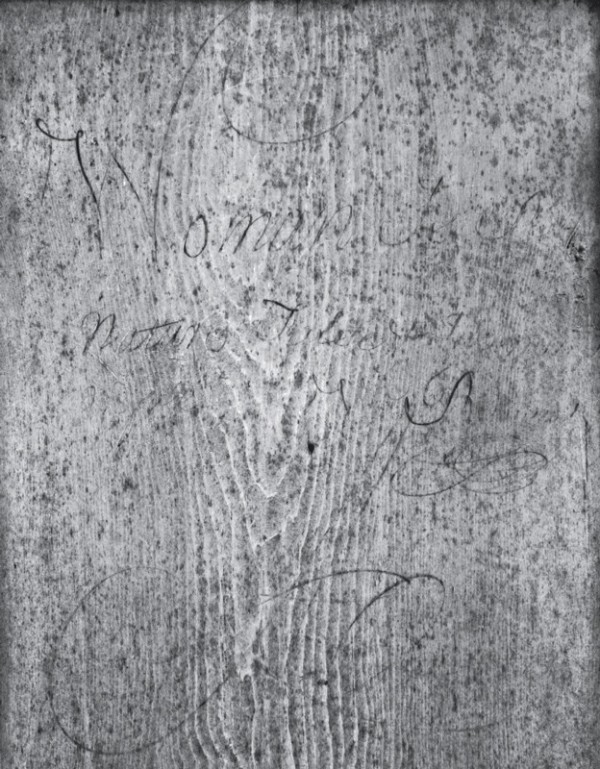
Detail of the inscription “Woman Is By/Nature False & Inconstan(t)/W[ ]fill/W Richardson” and letter “A” on the upper left drawer of the upper case of the high chest illustrated in fig. 1. (Courtesy, Sotheby’s.)
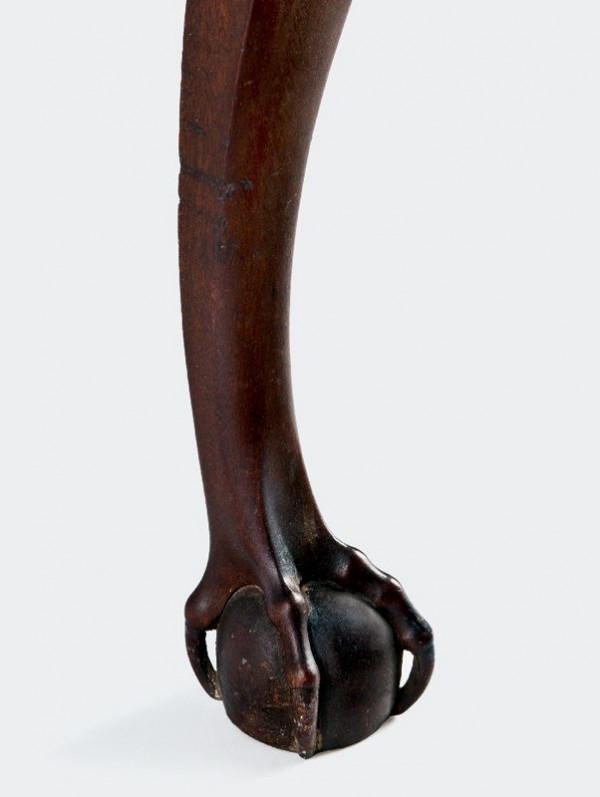
Detail of the leg and foot of the high chest illustrated in fig. 1. (Photo, Gavin Ashworth.)

Detail of the shell on the high chest illustrated in fig. 1. (Photo, Gavin Ashworth.) The shell is applied and the lobes are carved through into the skirt below. The joint is visible near the bottom of the shell.
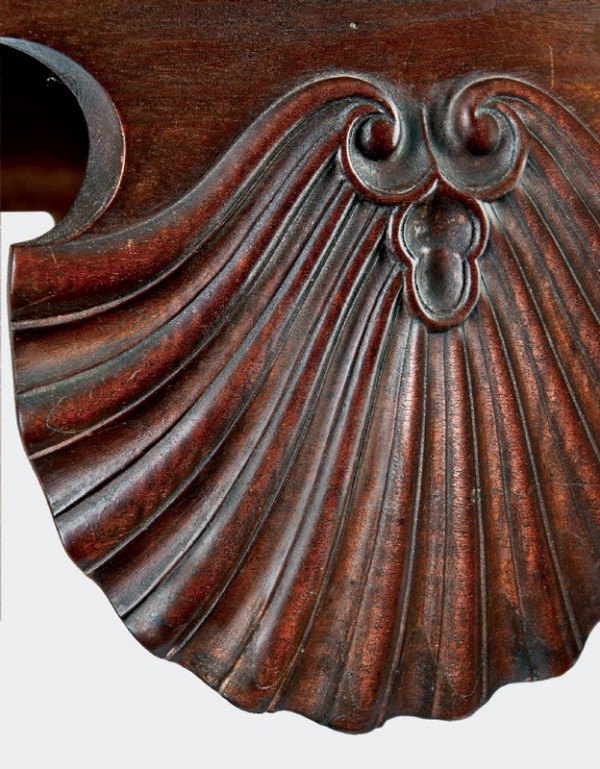
Detail showing the lamination line of the shell and skirt of the high chest illustrated in fig. 1. (Photo, Gavin Ashworth.)
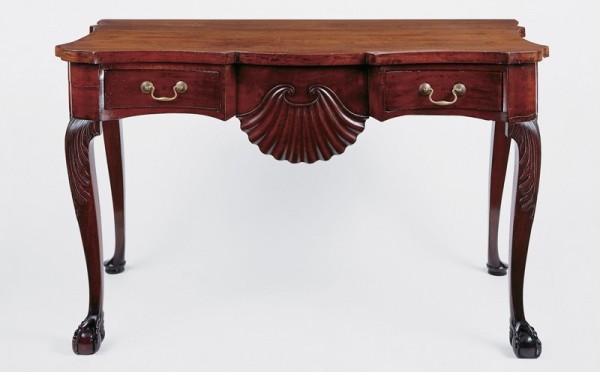
Pier table, Newport, Rhode Island, 1750–1765. Mahogany with red cedar. H. 30", W. 50", D. 25". (Courtesy, Redwood Library and Athenaeum, Newport, Rhode Island; photo, Gavin Ashworth.) The feet are similar to those on furniture documented and attributed to John Goddard. This table has been extensively reworked. The drawers are later additions, and the original top was probably marble.
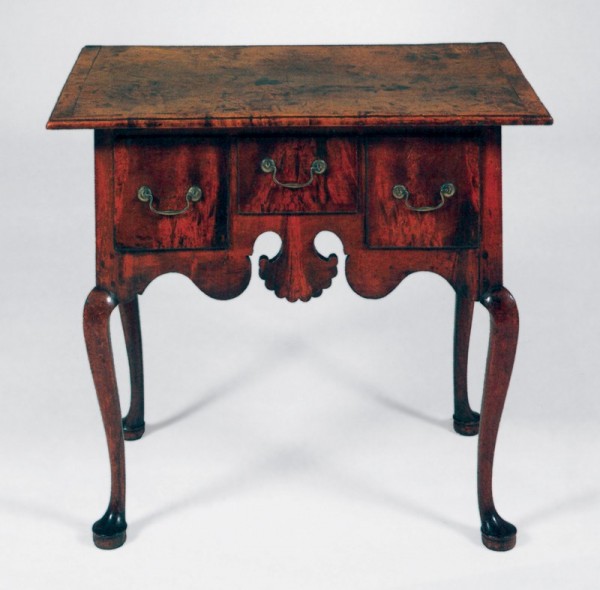
Dressing table, Stonington area, Connecticut, ca. 1765. Maple. H. 27 1/2", W. 31 3/4", D. 20". (Private collection; photo, Sotheby’s.)

High chest of drawers attributed to Christopher Townsend and John Townsend, Newport, Rhode Island, ca. 1755. Mahogany with tulip poplar. H. 92 1/4", W. 44 1/4", D. 22 3/4". (Private collection; photo, Gavin Ashworth.) The horizontal moldings at the base of the finial plinth are missing, but the chest retains its original hardware.

Detail of the leg and foot of the high chest illustrated in fig. 16. (Photo, Gavin Ashworth.)
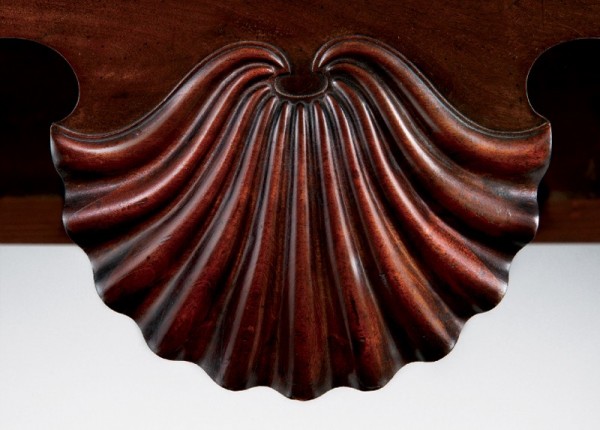
Detail of the shell on the high chest illustrated in fig. 16. (Photo, Gavin Ashworth.)
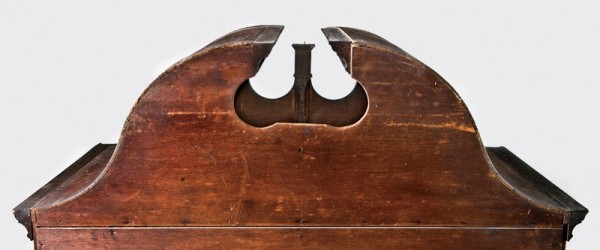
Detail showing the pediment backboard of the high chest illustrated in fig. 1. (Photo, Gavin Ashworth.) The upper portion of central plinth is lost.

Detail showing the pediment backboard of the high chest illustrated in fig. 16. (Photo, Gavin Ashworth.)
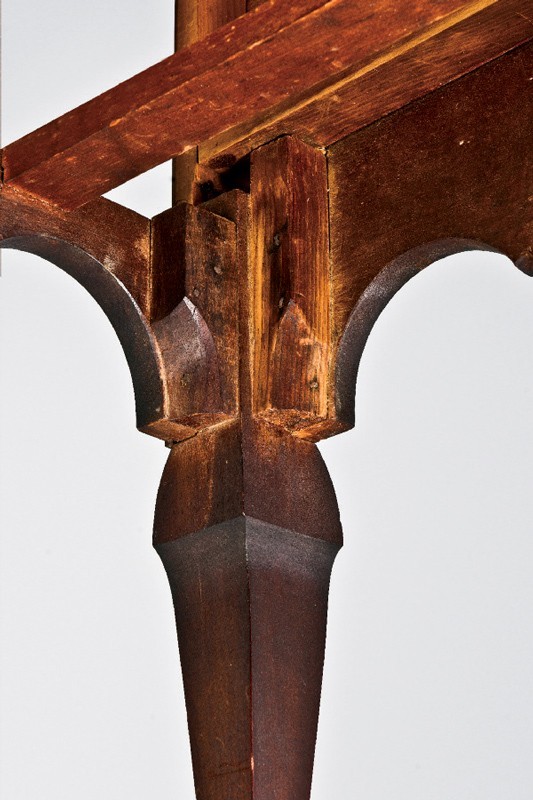
Detail of the glue blocks securing the left front leg of the high chest illustrated in fig. 1. (Photo, Gavin Ashworth.)
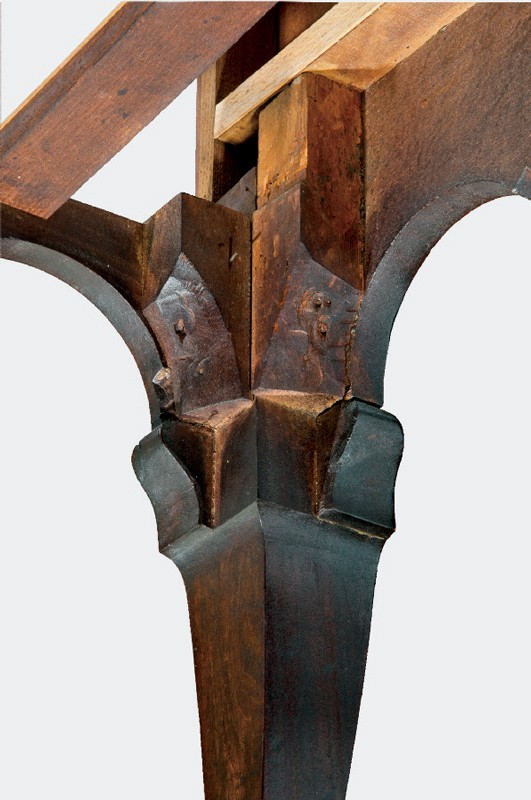
Detail of the glue blocks securing the left front leg of the high chest illustrated in fig. 16. (Photo, Gavin Ashworth.)
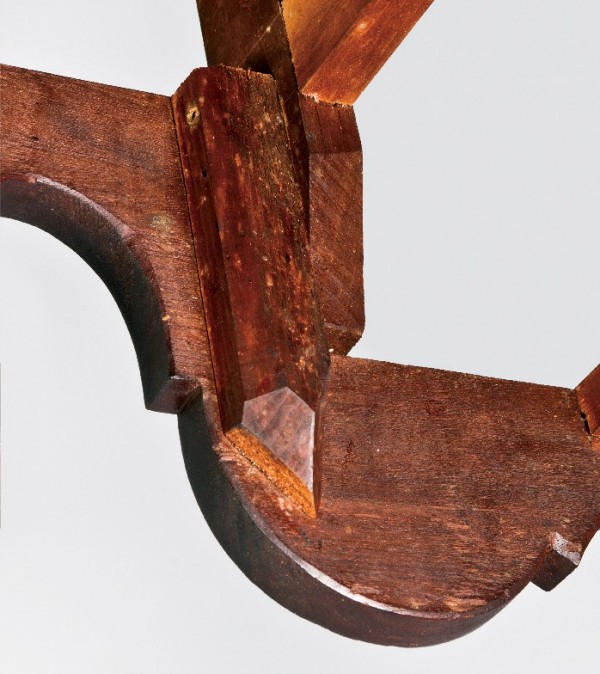
Detail of the glue block attached to the skirt and a vertical drawer divider on the high chest illustrated in fig. 1. (Photo, Gavin Ashworth.)
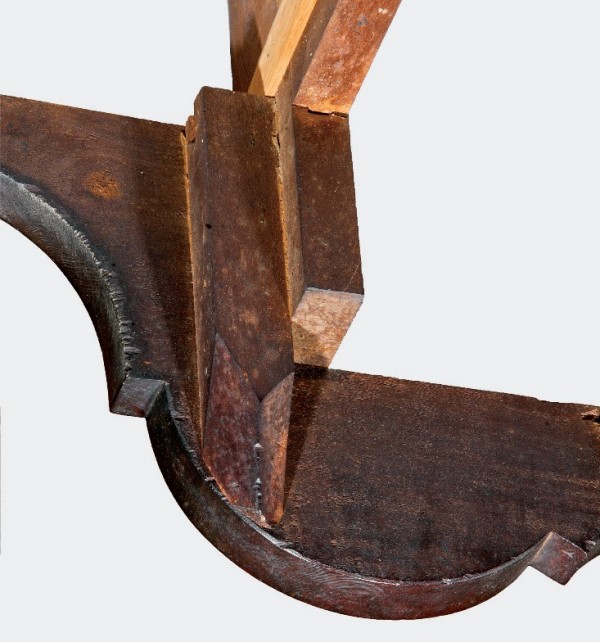
Detail of the glue block attached to the skirt and a vertical drawer divider on the high chest illustrated in fig. 16. (Photo, Gavin Ashworth.)
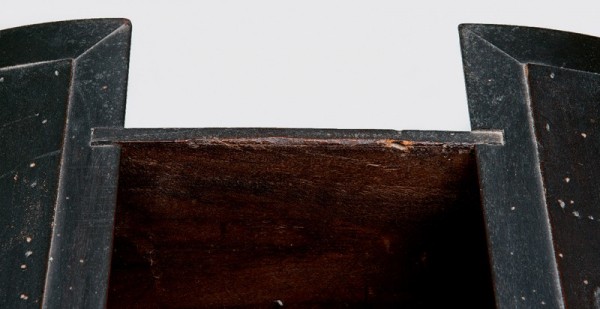
Detail of the board behind the oculi of the pediment of the high chest illustrated in fig. 16. (Photo, Gavin Ashworth.)
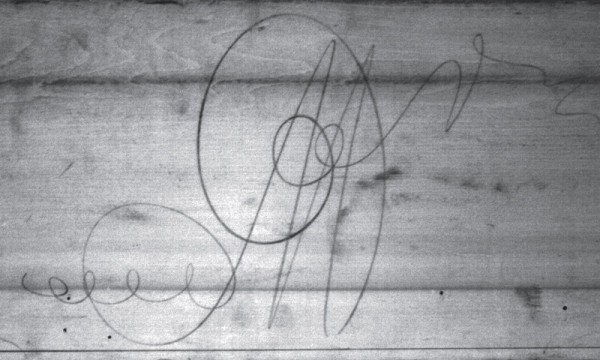
Detail of an “M” finishing mark on the high chest illustrated in fig. 16. (Photo, Erik Gronning.) John Townsend may have inscribed this finishing mark.
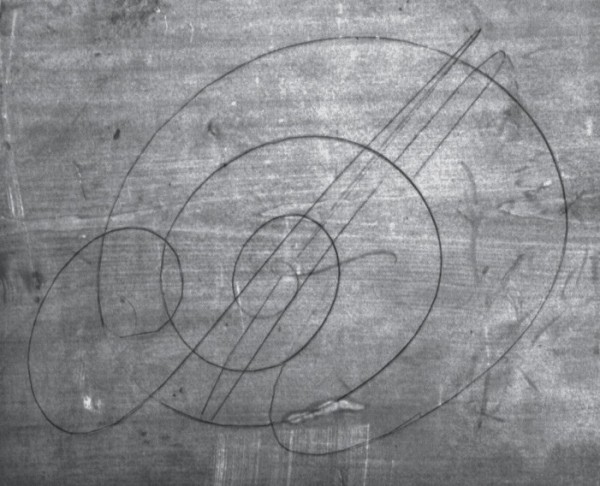
Detail of an “M” finishing mark on the high chest illustrated in fig. 16. (Photo, Erik Gronning.) Christopher Townsend may have inscribed this finishing mark.

Detail of the “B” inscribed on the high chest illustrated in fig. 16. (Photo, Erik Gronning.) The belly of the “B” is not nearly as exaggerated as that shown in fig. 29.
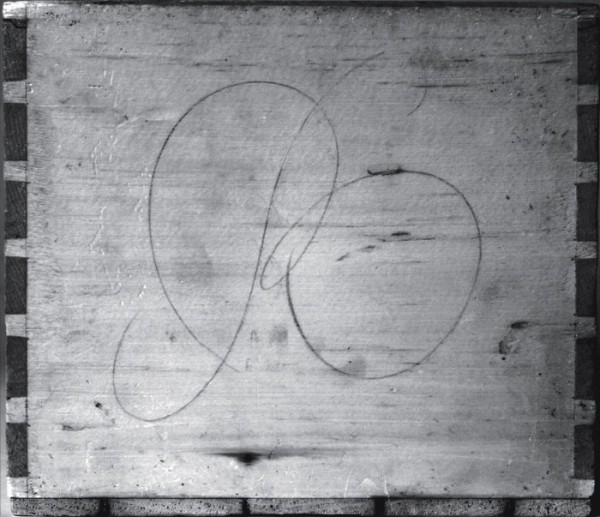
Detail of the “B” inscribed on the high chest illustrated in fig. 1. (Courtesy, Sotheby’s.)

Christopher Townsend, desk-and-bookcase, Newport, Rhode Island, ca. 1750. Mahogany throughout. Dimensions not recorded. (Private collection; Image © Metropolitan Museum of Art.) The brackets are original, but the ball feet below are conjectural replacements. As is the case with the Arnold and Wanton high chests (figs. 19, 20), the upper backboard of the Appleton bookcase is shaped to mirror the tympanum.
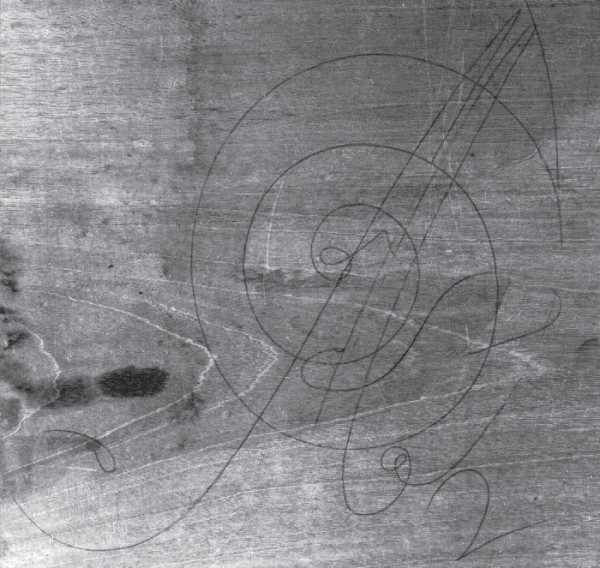
Detail of an “M” finishing mark on the desk-and-bookcase illustrated in fig. 30. (Courtesy, Sotheby’s).

Detail of the inscription “Made By Christopher Townsend” on the desk-and-bookcase illustrated in fig. 30. (Photo, Charlotte Hale, Sherman Fairchild Paintings Conservation Center, Metropolitan Museum of Art, Image © Metropolitan Museum of Art.)

Detail of the cornice molding and left finial of the desk-and-bookcase illustrated in fig. 30. (Photo, Gavin Ashworth.)
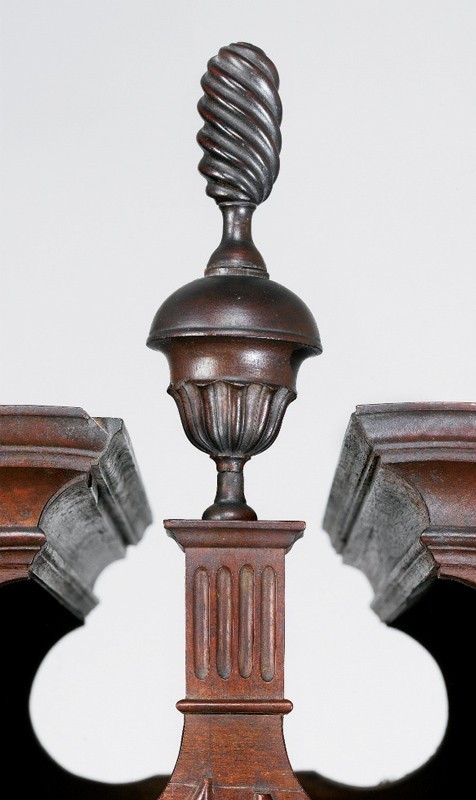
Detail of the finial on the high chest illustrated in fig. 1. (Courtesy, Sotheby’s.) The softer, more elliptical shape of the flame is unique in John Townsend’s work. The lowermost section of the finial is restored and would originally have been shorter, like the finial shown in fig. 33.
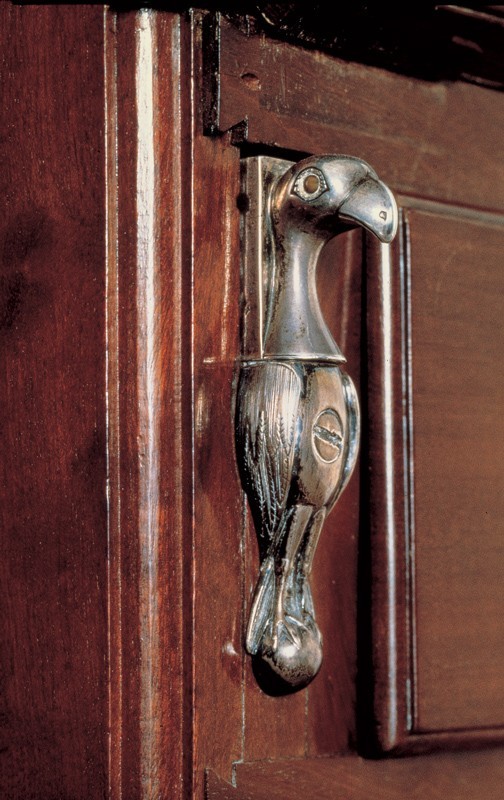
Detail of the silver mount on the left fallboard support of the desk-and-bookcase illustrated in fig. 30. (Courtesy, Sotheby’s.) The eyes are made from a cylinder of agate.
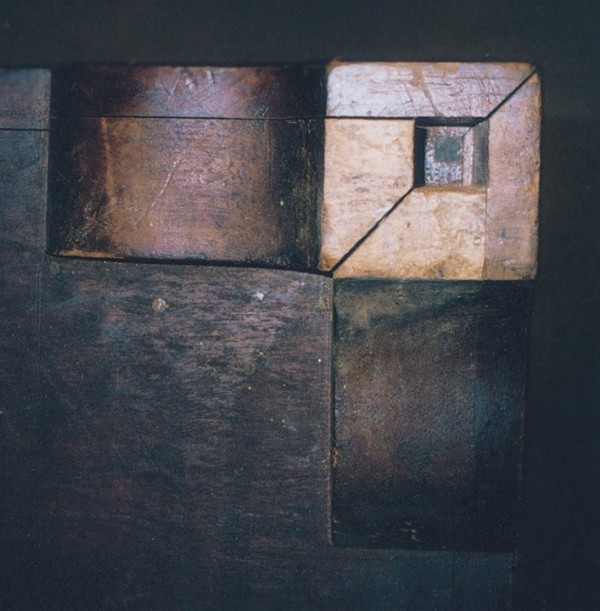
Detail showing the foot blocking on the desk-and-bookcase illustrated in fig. 30. (Photo, Leslie Keno.) The glue blocks are neatly finished to conform to the shape of the brackets.
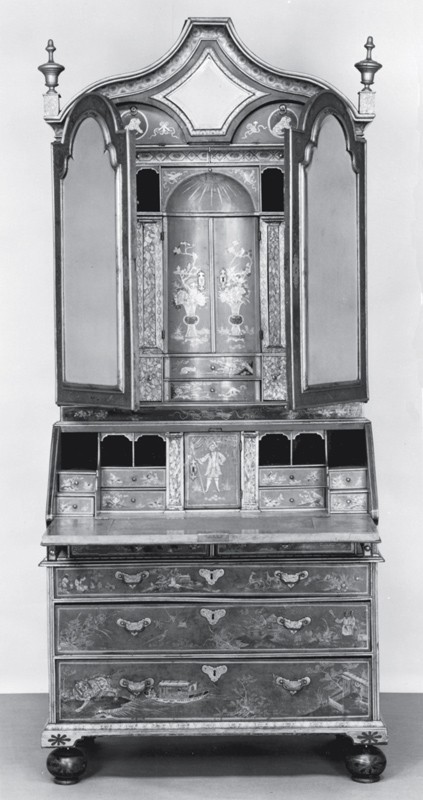
Desk-and-bookcase, England, 1700–1720. Oak with pine. H. 81 1/8", W. 43 7/8", D. 23 1/2". (Metropolitan Museum of Art, Gift of James De Lancey Verplanck and John Bayard Rogers Verplanck, 1939 [39.184a,b]. Image © Metropolitan Museum of Art.)
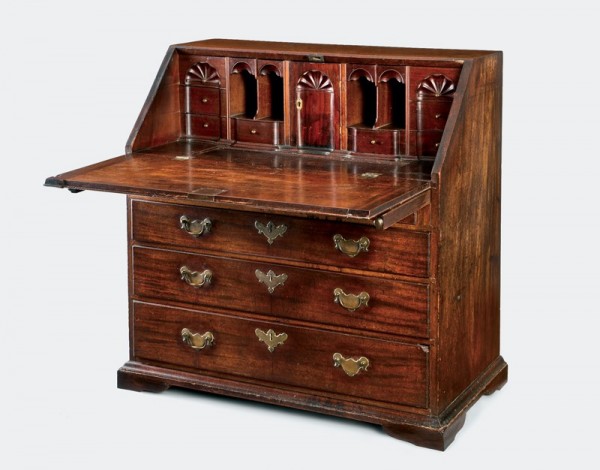
Christopher Townsend, desk, Newport, Rhode Island, ca. 1750. Mahogany with mahogany, cedrela, and tulip poplar. H. 37 1/4", W. 35 5/8", D. 20 1/4". (Private collection; photo, Gavin Ashworth.) The lower portions of the feet are missing, but the desk has its original brass, hardware, and finish.
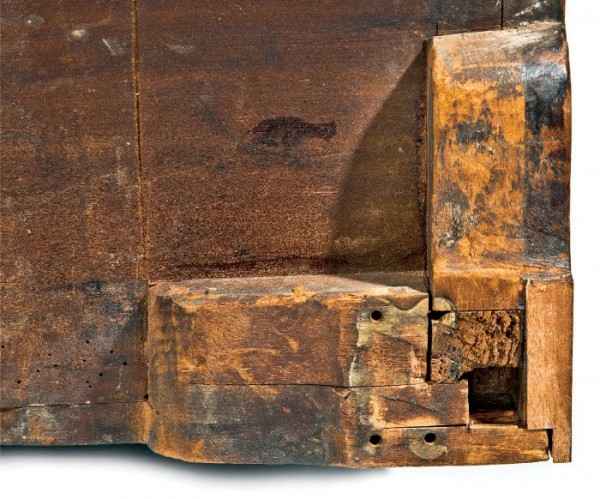
Detail showing the foot blocking of the desk illustrated in fig. 38. (Photo, Gavin Ashworth.)
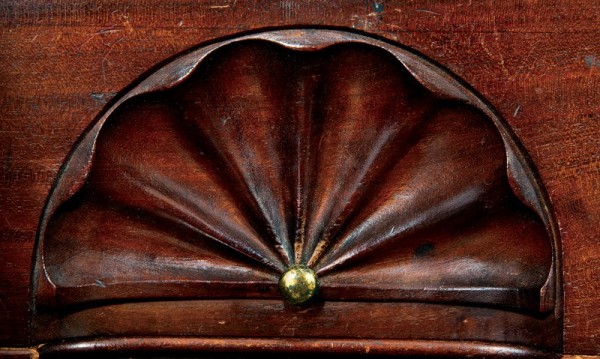
Detail of a shell on an interior drawer of the desk illustrated in fig. 38. (Photo, Gavin Ashworth.)
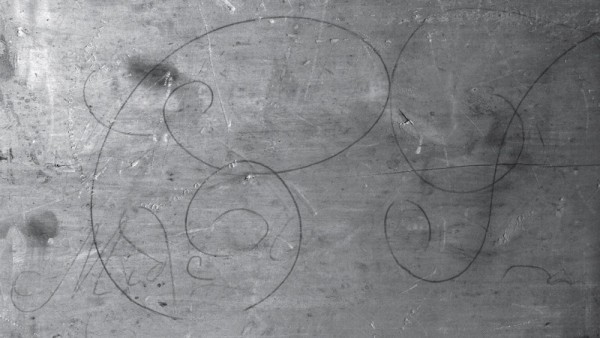
Detail of the inscription “Made by C T” on the bottom of desk illustrated in fig. 38. (Photo, Erik Gronning.)
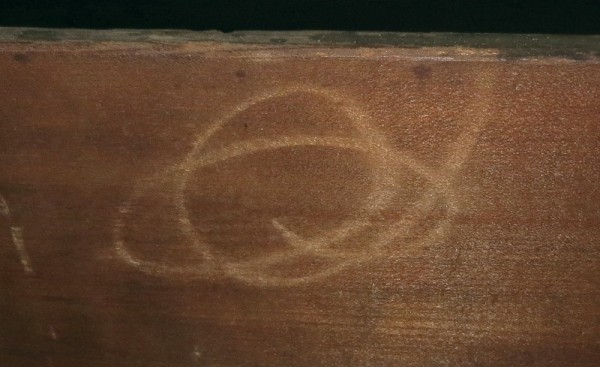
Detail of a chalk finishing mark on the back of an exterior drawer of the desk illustrated in fig. 38. (Photo, Erik Gronning.)

Details showing the letters on the backs of the exterior drawers of the desk illustrated in fig. 38. (Photo, Erik Gronning.)

Desk attributed to Christopher Townsend, Newport, Rhode Island, ca. 1750. Mahogany with tulip poplar, chestnut, cedrela, and white pine. H. 42", W. 36 1/2", D. 22". (Private collection; photo, Sotheby’s.) The feet are replaced.

Detail of the brass mount on the left fallboard support of the desk illustrated in fig. 44. (Courtesy, Sotheby’s.) The eyes are made from a cylinder of agate.

Details of the inscription on the back of an exterior drawer of the desk illustrated in fig. 44. (Photo, Erik Gronning.) The upper image shows the orientation of the board when the inscription was made prior to assembly. The lower image is as it appears with the grain oriented horizontally.
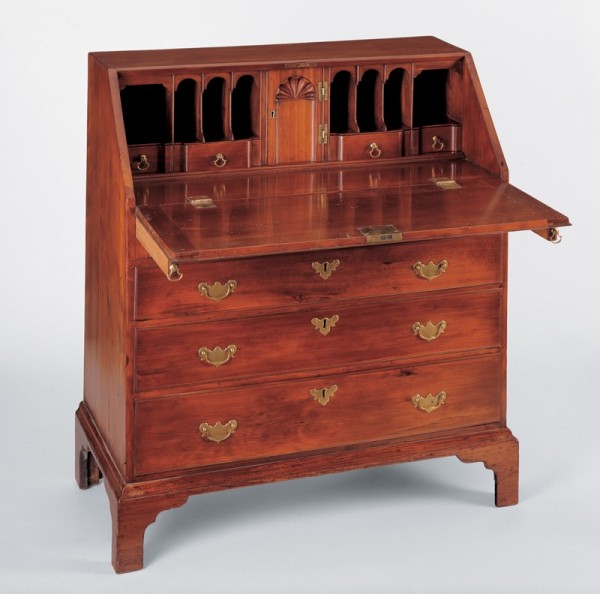
Desk attributed to Christopher Townsend, Newport, Rhode Island, ca. 1750. Cedar. H. 41 1/4", W. 35 7/8", D. 19 3/4". (Courtesy, Caxambas Foundation; photo, Gavin Ashworth.)
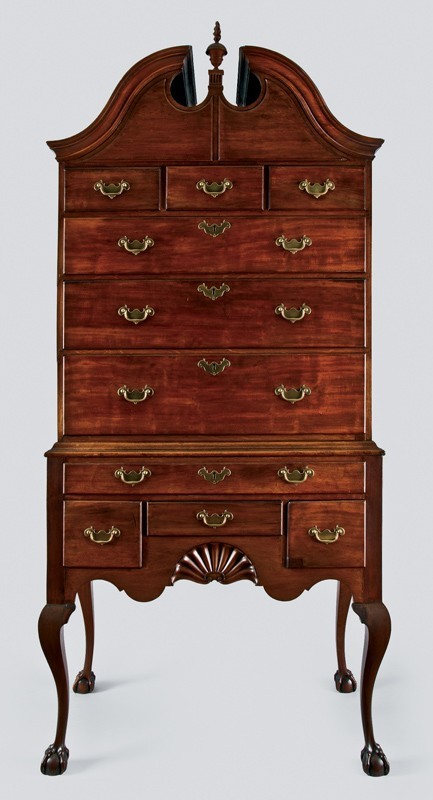
Christopher Townsend and John Townsend, high chest of drawers, Newport, Rhode Island, ca. 1755. Mahogany with yellow poplar, chestnut, white pine, and mahogany. H. 87 13/16", W. 40 1/2", D. 22 3/4". (Courtesy, Philadelphia Museum of Art; photo, Gavin Ashworth.) The chest retains its original hardware.

Detail showing the “John T” and “Christopher Townsend” inscriptions on the lower-case drawer blade of the high chest illustrated in fig. 48.

Detail of a leg and foot of the high chest illustrated in fig. 48. (Photo, Gavin Ashworth.)

Detail of the shell on the high chest illustrated in fig. 48. (Photo, Gavin Ashworth.)
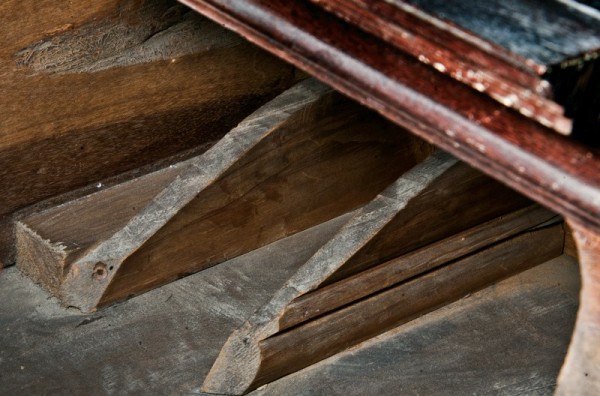
Detail of a piece of molding used in the construction of the pediment of the high chest illustrated in fig. 48. (Photo, Gavin Ashworth.)
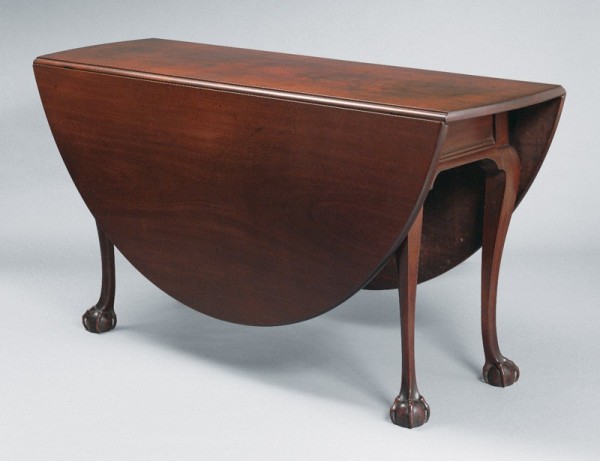
John Townsend, dining table, Newport, Rhode Island, 1756. Mahogany with soft maple, red oak, and hickory. H. 28 3/4", W (open). 62 1/4", W (closed). 17 1/2", D. 58 1/4". (Metropolitan Museum of Art, Gift of Stuart Holzer and Marc Holzer, in memory of their parents, Ann and Philip Holzer, 2012. Image © Metropolitan Museum of Art.)
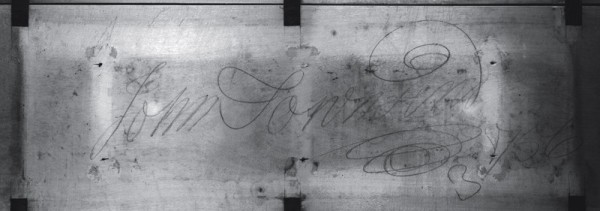
Detail of the inscription “ John Townsend 1756/3,” on the dining table illustrated in fig. 53. (Image © Metropolitan Museum of Art.)

Detail of a leg and foot of the dining table illustrated in fig. 53. (Image © Metropolitan Museum of Art.) The central talon on the foot is replaced.

Detail of the inscription “For Israel / A” on the dining table illustrated in fig. 53. (Image © Metropolitan Museum of Art.)
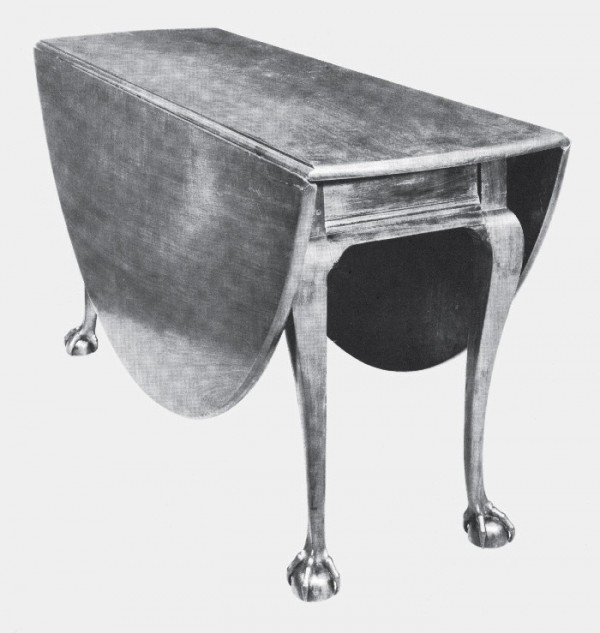
Dining table attributed to Christopher Townsend, Newport, Rhode Island, ca. 1755. Mahogany. H. 30 1/2", W (open). 69", D. 62". (Antiques 110, no. 98 [September 1970]: 292.)
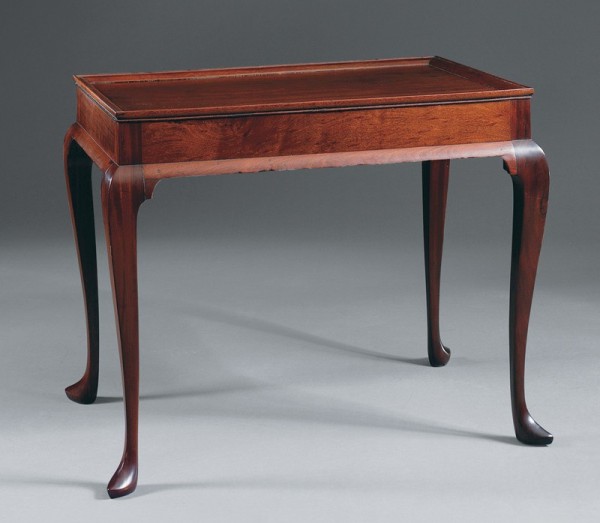
Christopher Townsend, tea table, Newport, Rhode Island, ca. 1750. Mahogany. H. 25 3/4", W. 21 3/8". (Private collection; photo, Sotheby’s.)

Detail of the inscription “C Townsend joynd the piece” on the tea table illustrated in fig. 58. (Courtesy, Sotheby’s.)
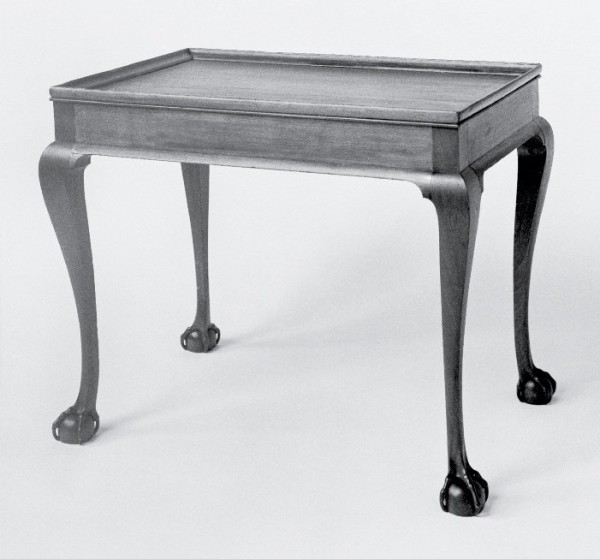
Tea table attributed to John Townsend, Newport, Rhode Island, ca. 1760. Mahogany. H. 26 1/4", W. 19 5/16", D. 19 3/8". (Courtesy, Museum of Art, Rhode Island School of Design, Providence; photo, Erik Gould.)

Christopher Townsend, high chest of drawers, Newport, Rhode Island, 1748. Walnut with white pine. H. 70", W. 38 1/2", D. 20 1/2". (© 2013. Collection of Gerald and Kathleen Peters; photo, Gavin Ashworth.)

Detail of the inscription “Christopher Townsend made 1748” on the high chest illustrated in fig. 61. (Photo, Charlotte Hale, Sherman Fairchild Paintings Conservation Center. Image © Metropolitan Museum of Art.)
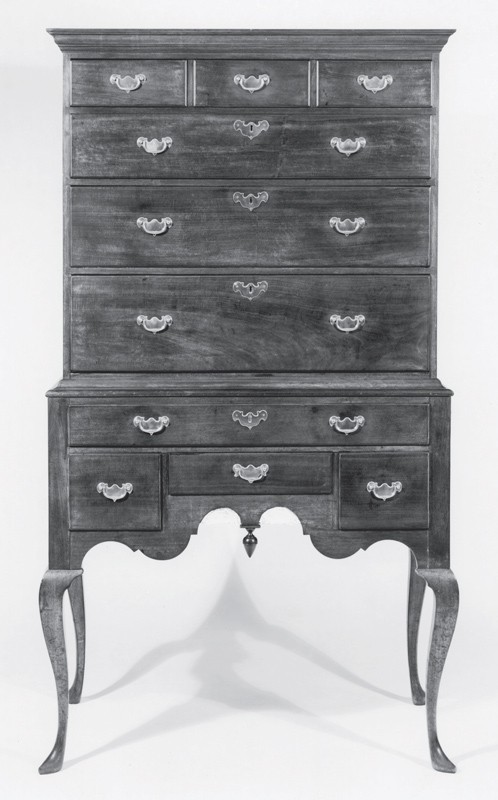
High chest of drawers attributed to Christopher Townsend, Newport, Rhode Island, ca. 1750. Mahogany with white pine and yellow poplar. H. 72", W. 39", D. 21". (Private collection; photo, Israel Sack, Inc., Archive, Yale University Art Gallery.) This high chest was originally made for George Hussey (d. 1782) of Nantucket, Massachusetts.
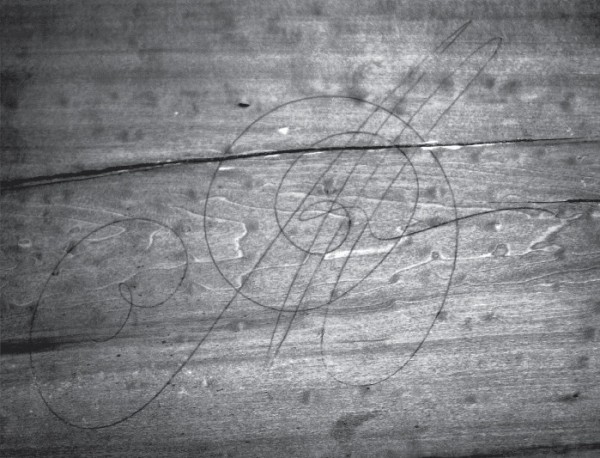
Detail of the “M” finishing mark on the high chest illustrated in fig. 63. (Photo, Erik Gronning.)
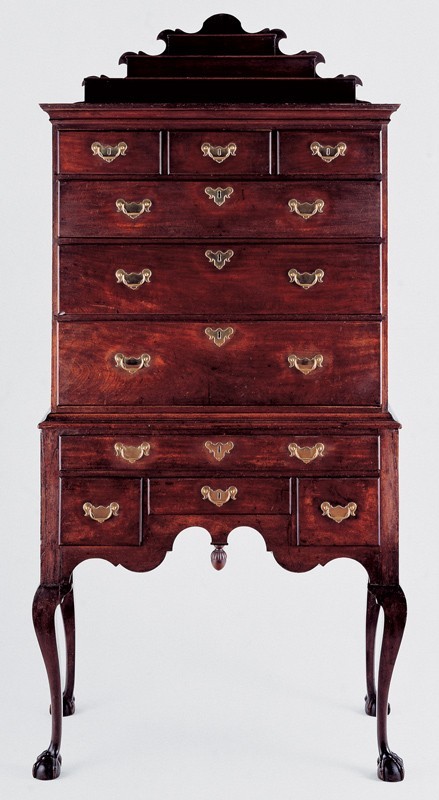
High chest of drawers attributed to Christopher Townsend, Newport, Rhode Island, ca. 1755. Mahogany with white pine and yellow poplar. H. 83 5/8", W. 40 1/2", D. 22 1/4". (Chipstone Foundation; photo, Gavin Ashworth.) The chest retains its original cast brass hardware and finish. Made in three sections and secured with glue blocks, the china shelves are inscribed twice with a chalk “A.” As is the case with other flat-top high chests documented and attributed to Christopher Townsend, the rear legs are glued into a shallow rabbet in the backboard.

Detail of a claw-and-ball foot of the high chest illustrated in fig. 65. (Photo, Gavin Ashworth.)
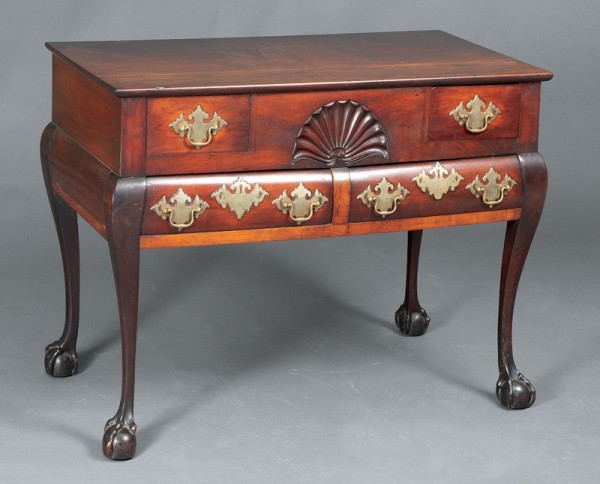
Bureau table with legs attributed to John Townsend, Newport, Rhode Island, ca. 1760. Mahogany with chestnut and tulip poplar. H. 27", W. 40 1/4", D. 22". (Courtesy, Schuyler Mansion State Historic Site, New York State Office of Parks, Recreation and Historic Preservation.) The case has fine dovetails and a deep shell carving consistent with furniture from John Townsend’s shop, but owing to alterations, only the legs and feet can be attributed to him. This object may have started out as a pier table or side table.

Detail of a leg and foot of the bureau table illustrated in fig. 67. The side and front talons are replaced.
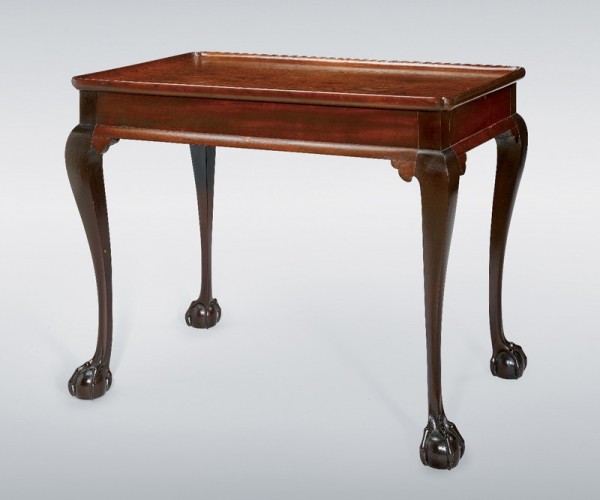
Tea table attributed to Christopher Townsend, Newport, Rhode Island, ca. 1760. Mahogany with chestnut. H. 26", W. 33 1/2", D. 20 1/2". (Courtesy, Museum of Fine Arts, Houston, Bayou Bend Collection, gift of Miss Ima Hogg.) The table has a chestnut cross-brace dovetailed at the midpoint of the long rails and a top secured with glue blocks. The knee returns are replaced.

Detail of a leg and foot of the tea table illustrated in fig. 69.
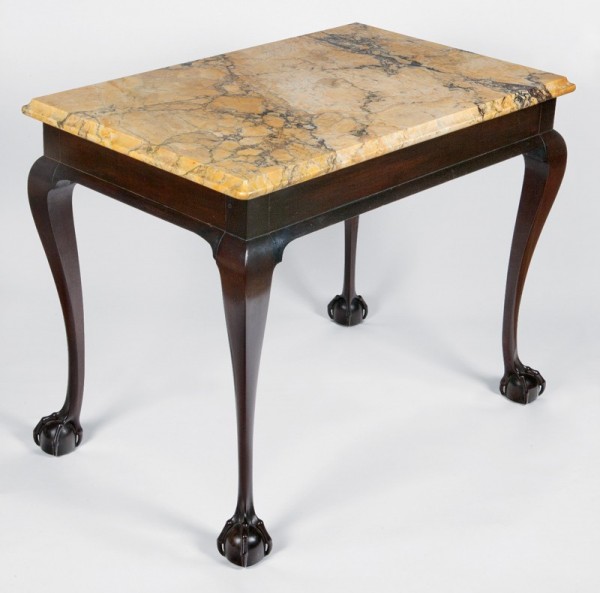
Tea table attributed to Christopher or John Townsend, Newport, Rhode Island, ca. 1760. Mahogany. H. 25", W. 33 3/4", D. 21 1/4". (Private collection; photo, Michael J. Smith.) The second phalange on the toes is slightly more elongated than those on the Arnold high chest. This is the only marble-top Newport tea table known, but its design and size are consistent with the Sweet and Weeden tables.

Detail of a leg and foot of the tea table illustrated in fig. 71. (Photo, Michael J. Smith.)
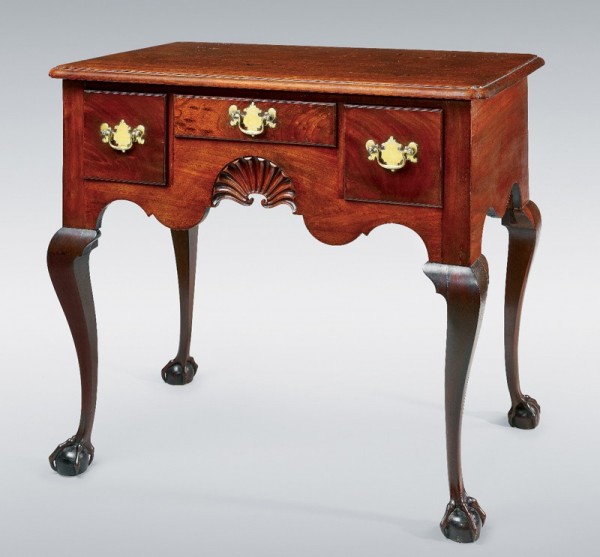
Dressing table attributed to Christopher or John Townsend, Newport, Rhode Island, ca. 1755. Mahogany with white pine, yellow poplar, chestnut, and mahogany. H. 31", W. 35 3/4", D. 22". (Courtesy, Museum of Fine Arts, Houston, Bayou Bend Collection, gift of Miss Ima Hogg.)
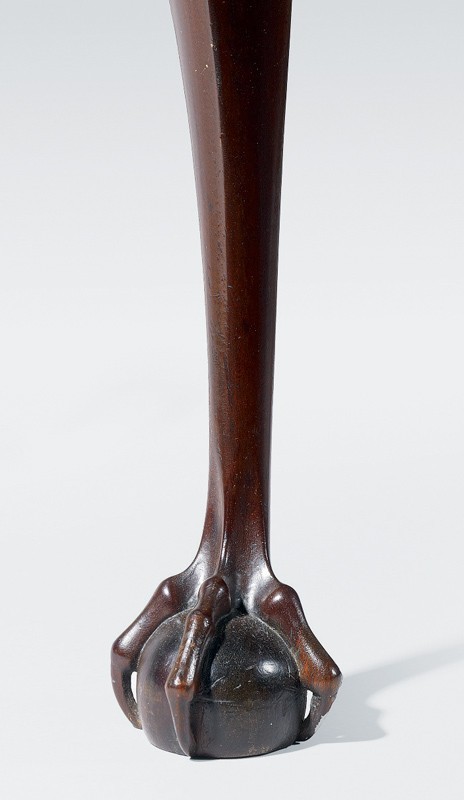
Detail of a leg and foot of the dressing table illustrated in fig. 73.

Detail of the shell of the dressing table illustrated in fig. 73.
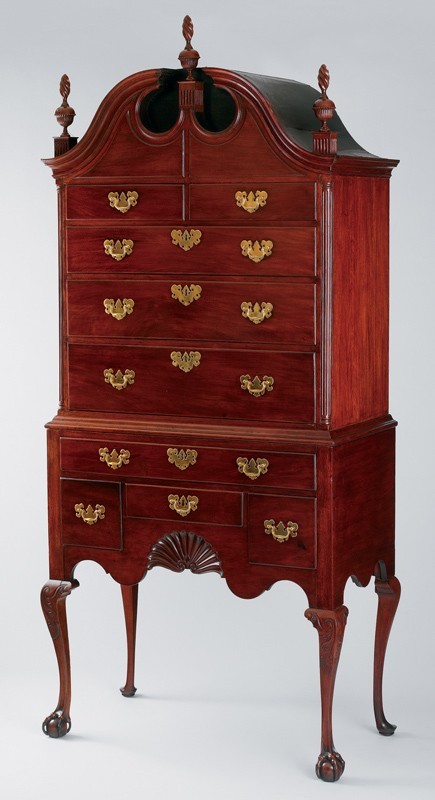
John Townsend, high chest of drawers, Newport, Rhode Island, 1759. Mahogany with chestnut, eastern white pine, and cottonwood. H. 88 3/4", W. 39 3/8", D. 22 1/8". (Courtesy, Yale University Art Gallery, New Haven, Connecticut, bequest of Doris M. Brixey.) Christopher Townsend may also have used the fleur-de-lis broken motif seen on the shell of this chest. A mahogany high chest base with that feature has ball-and-claw feet remarkably similar to those made by Christopher (CRN Auctions, Americana and English Antiques, American and European Works of Art, Chinese, and Jewelry, Cambridge, Massachusetts, September 9, 2012, lot 107).

Detail of the inscription “No. 28 / Made By / John Townsend / Newport / 1759” on the high chest illustrated in fig. 76.
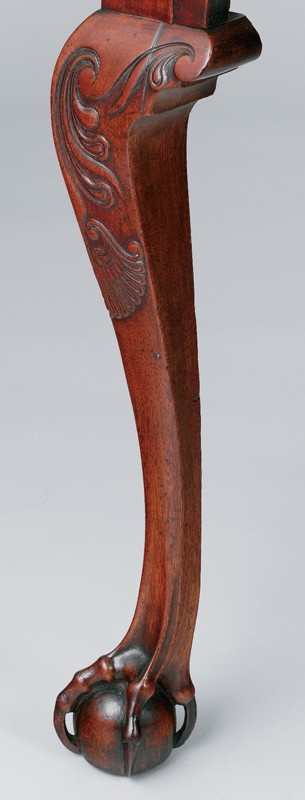
Detail of a leg and foot of the high chest illustrated in fig. 76.

Detail of a foot of the high chest illustrated in fig. 76. A space can be seen above the ball.

John Townsend, document cabinet, Newport, Rhode Island, ca. 1755. Mahogany. H. 27 1/2", W. 25 3/4", D. 12 7/8". (Private collection; photo, Christie’s.) The cabinet has Townsend’s drawer lettering system. The backs of the drawers are inscribed in graphite “A,” “B,” “C,” “D,” from top to bottom on the right, and “E,” “F,” “G,” and “H,” from top to bottom on the left. Townsend used book-matched pieces of wood for drawers A and E, consecutive pieces cut from the same log for drawers B and D, and contiguous pieces from the same flitch for drawers G and H.
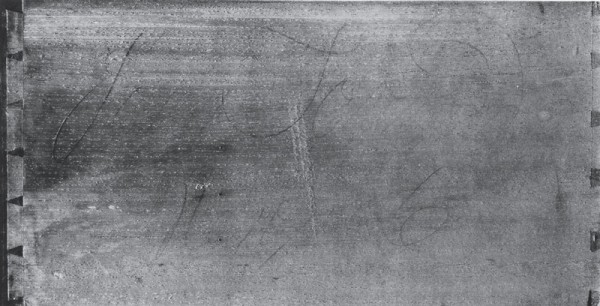
Detail of the inscription “John Townsend / Newport” on the document cabinet illustrated in fig. 80. (Photo, Gavin Ashworth.)
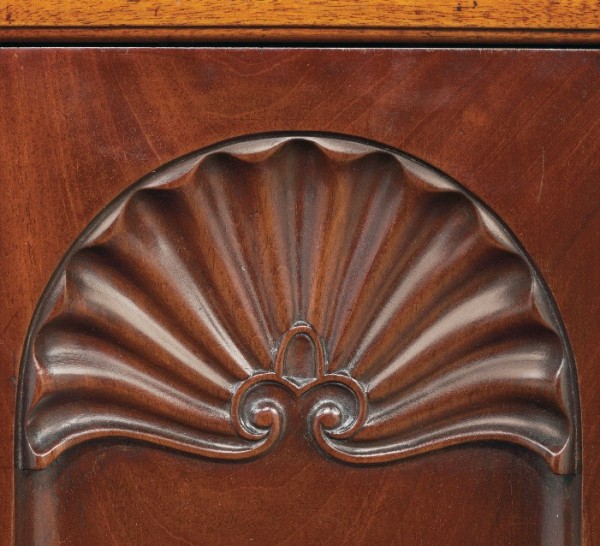
Detail of the shell on the door of the cabinet illustrated in fig. 80. (Photo, Christie’s.)

Chest of drawers attributed to John Townsend, Newport, Rhode Island, ca. 1756. Mahogany with eastern white pine and yellow poplar. H. 38 1/8", W. 38 1/2", D. 20 1/8". (Courtesy, Diplomatic Reception Rooms, U.S. Department of State, Washington, D.C.) The chest retains its original hardware, but the bottom 3 1/2 inches of the feet are replaced. The top drawer is secured with a spring lock that is reached by opening the drawer below.

Detail showing the two-piece construction of the shell on the chest of drawers illustrated in fig. 83. (Photo, Erik Gronning.)
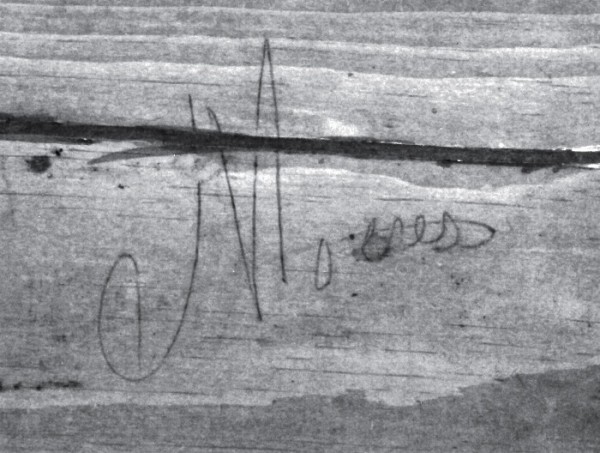
Detail of the inscription “Moses” on the chest of drawers illustrated in fig. 83. (Photo, Erik Gronning.)

Slant-front desk attributed to John Townsend, Newport, Rhode Island, ca. 1755. Mahogany. H. 42", W. 37", D. 19 1/2". (Private collection; photo, Sotheby’s.) The desk retains its original hardware, but the feet are replacements.

Detail of the partial inscription “J [ ] Newport” on the desk illustrated in fig. 86. (Photo, Erik Gronning.)

Detail of the inscription “James Harden” on the desk illustrated in fig. 86. (Photo, Erik Gronning.)

High chest of drawers attributed to John Townsend, Newport, Rhode Island, ca. 1757. Mahogany with mahogany and white pine. H. 87", W. 40 3/4", D. 22". (Photo, 2012 Museum of Fine Arts, Boston.) The construction of this high chest is consistent with John Townsend’s early work, but the backboard of the pediment has a semicircular cutout rather than shaping that matches the tympanum. All of the drawer fronts were veneered at a later date.
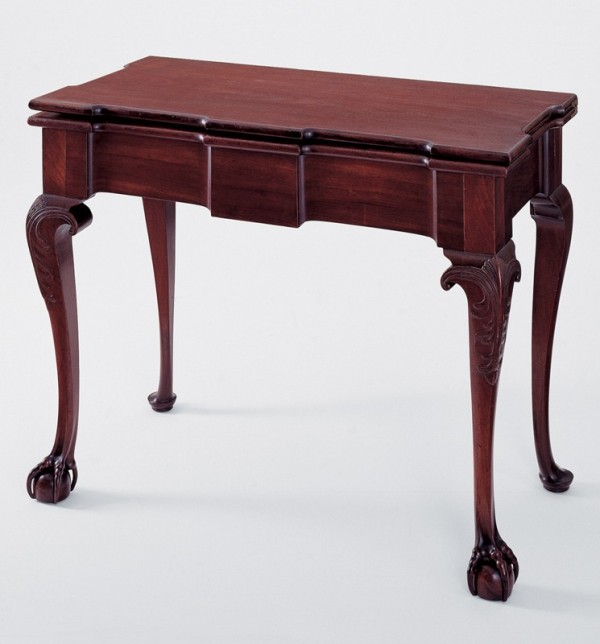
Card table attributed to John Townsend, Newport, Rhode Island, ca. 1760. Mahogany with maple and white pine. H. 27 1/2", W. 35 1/2", D. 18 1/2". (Courtesy, Chipstone Foundation.) This table descended in the family of Stephen Hopkins (1707–1785), who was a governor of Rhode Island and a signer of the Declaration of Independence.
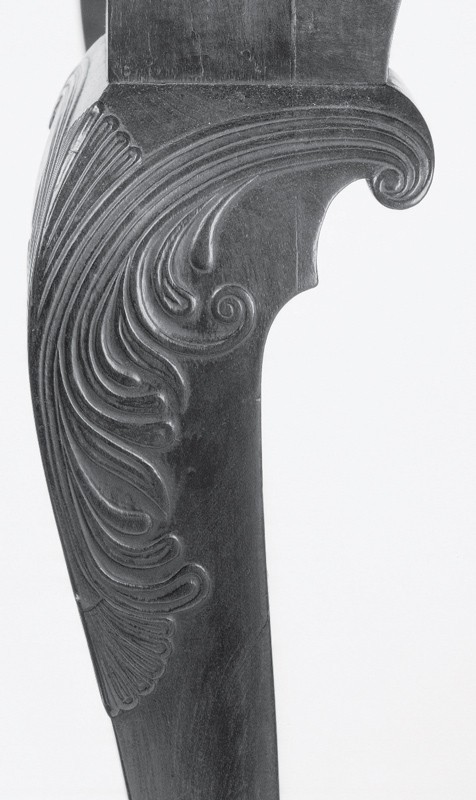
Detail of the knee carving on the high chest illustrated in fig. 89. (Photo, 2012 Museum of Fine Arts, Boston.)
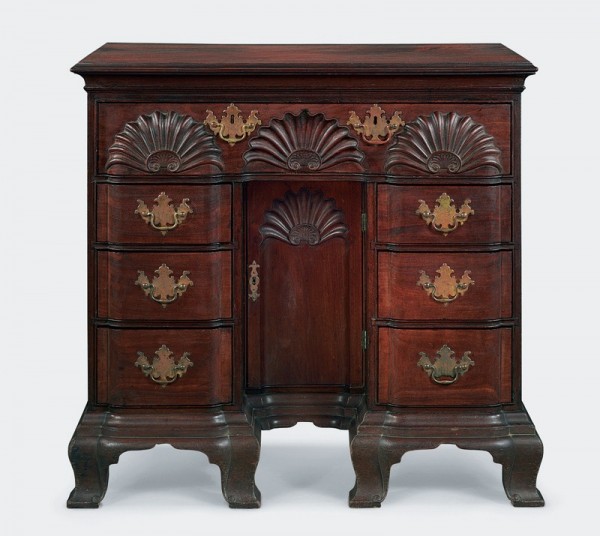
Jonathan Townsend, block-and-shell bureau table, Newport, Rhode Island, 1767. Mahogany. H. 32 1/2", W. 36 1/2", D. 20". (Courtesy, Christie’s Images Limited 2013.) Jonathan Townsend was twelve years younger than his brother John.

Detail showing the graphite signature on the bureau table illustrated in fig. 92. (Photo, Erik Gronning.)
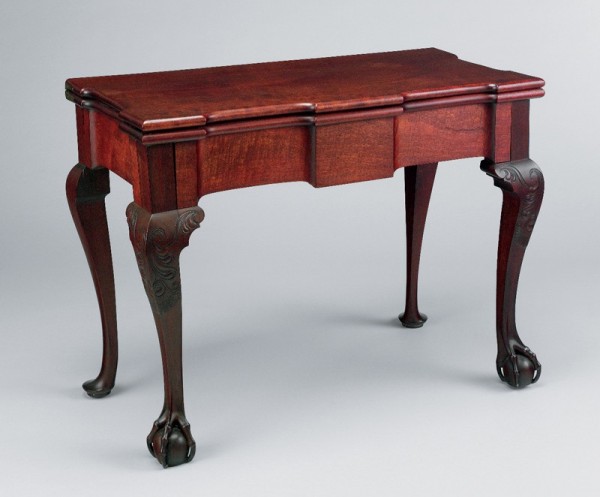
John Townsend, card table, Newport, Rhode Island, 1762. Mahogany with chestnut, maple, and white pine. H. 27 1/4", W. 35", D. 16 1/2". (Courtesy, 63rd Street Equities; Image © Metropolitan Museum of Art.)
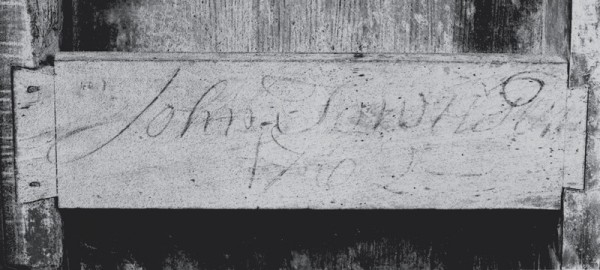
Detail showing the graphite signature on the card table illustrated in fig. 94. (Image © Metropolitan Museum of Art.)

Detail of the knee carving on the card table illustrated in fig. 94. (Image © Metropolitan Museum of Art.)
